By Izida Petravičiūtė von Braun
In 1978, in the journal Lituanus, Professor Stasys Goštautas of Boston University, wrote about Petravičius and his art as follows: “Never since the delightful graphic art of the primitive and anonymous artists of the eighteenth century, has Lithuanian art exhibited such a pure and candid interpretation of its national sprit, as in the early drawings of Viktoras Petravičius. Petravičius is the central figure of Lithuanian graphic art of the 20th century. Isolated and born a rebel, Petravičius has radiated his influence over his contemporaries and the whole generation of young artists in Lithuania and abroad.”
Early life in Lithuania and Europe

Viktoras Petravičius was born on May 12, 1906, in the village of Bedaliai, Lithuania (Šakiai district municipality) and graduated from Aušra High School in the village. He began his art studies in 1926 at the Kaunas School of Fine Arts where he was a student of Adomas Galdikas. Petravičius had his own “primitive” style and because of his unorthodox, nonconformist style, some of the faculty believed that he should be dismissed from the school. Galdikas, however, insisted that “Viktoras Petravičius is my protégé” and would bring honor to the country. The first group showings of his prints in Kaunas and Klaipėda were disappointing, as public opinion was negative; however, by his final year at the school Petravičius’ talent was recognized. In 1933 he graduated from Prof. Mstislav Dobužinskis School of Decoration and Graphic Art in Kaunas and in 1935 he graduated from the Kaunas School of Fine Arts.
Petravičius was then awarded a scholarship by the Lithuanian government to study in Paris, France. He traveled to Paris to attend the Conservatoire national des arts et métiers and l’École nationale supérieure des Beaux-Arts. Since he was on a scholarship and received payments periodically, he had some discretionary income beyond room and board. When money was available, he would treat his artist friends such as Paulius Augius, Liudas Vilimas, and Adolfas Valeška to traditional French wine, bread, and sausages. The others would reciprocate when they could and at times they would trade a picture for some bread and wine.
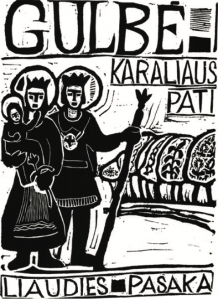
In Paris he produced illustrations for fairy tales, which occupy an exclusive place in Lithuanian folk literature. In 1937 he was awarded the Grand Prix at the Paris International Exhibition of Art and Technology for his illustrations in the book, Gulbė Karaliaus Pati, (“Swan, Wife of the King”) – a Lithuanian folk tale published by the ‘Society of 27 Book Lovers.’ This was the first significant international recognition of a book about Lithuanian folk literature. In 1939, the ‘Society’ also exhibited the “Swan” at the International Exhibition of New York. Additionally, Petravičius received the Diplôme Membre du Jury at the International Art Exhibition in Paris for his work. Another masterpiece from this early period was Marti iš Jaujos (“Bride from the Barn”), produced at the end of his based on myths and legends with Christian influences. It was published by the ‘Society of 27 Book Lovers’ in 1940 and translated into both French and German.
Ingrida Korsakaitė PhD, art historian and writer at the Institute of Culture and Art in Vilnius wrote that “Swan, Wife of the King” and the “Bride from the Barn” exhibited a consolidation of pagan and Christian cultural components and a worshipful attitude toward nature – with strong emotions and untamed expressiveness…“The two cycles of these illustrations deal with the theme of love between man and woman and of marriage. ”
In 1938 he graduated from the Conservatoire national des arts et métiers and l’École nationale supérieure des Beaux-Arts in Paris, France. In 1939 he returned to Kaunas, Lithuania. In Kaunas he exhibited woodcuts, linocuts and oil paintings from his impressions of Paris and travels to Switzerland, Italy and the Mediterranean.

Petravičius taught and was chairman of the Decorative Arts department at the Kaunas Applied Arts Institute in Lithuania from 1940 to 1941 and the Vilnius Fine Arts Academy from 1941 to 1944. In 1940 he created the stage and costume designs for the play ‘Skirgaila’ for the State Theater of Kaunas. ‘Skirgaila’ by Vincas Krėvė is a four act historical drama depicting Lithuania’s struggle for statehood in the 14th century.
In 1944 Petravičius, his wife and children fled to Vienna, Austria with many other Lithuanian intellectuals to escape the second Soviet occupation. In 1945 he and his family moved to Munich, Germany. In 1946 he established the UNRRA (United Nations Relief and Rehabilitation Administration) sponsored Munich art school in the US occupation zone and opened a private studio. Additionally, he developed a close relationship with the faculty of the Freiburg School of Art in the French occupation zone established by Vytautas Jonynas where many of his friends taught. In 1946 a monograph of 40 woodcuts by four artists – Telesforas Valius, Paulius Augius, Vaclovas Ratas and Viktoras Petravičius was published in Augsburg, West Germany. The following year he created a series of bookplates (ex libris) to commemorate the 400th anniversary of the Lithuanian printed book.
Exile in the United States
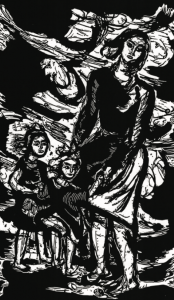
In 1949, the Petravičius family immigrated to the United States and settled in Chicago. He began work in a Cicero steel plant. He also worked at home on projects and received the Alumni Association Award in 1951 at the Art Institute of Chicago for his linocut ‘My Homeland.’ From 1951–1954 he worked as a designer at the stained glass studios of De Prato, Hatchert, Drihobel and Serbicky. The stained glass windows designed by the artist are installed in churches throughout the United States. In 1956 he received an award for a mosaic project for St. Sebastian Church at an exhibition for Lithuanian religious art in Chicago. He received commissions from churches, various theater productions and private individuals.
Loss of his motherland, the hardships of the war in Germany and resettlement in the United States brought more difficulties. Although he could not speak English, he managed to share his knowledge and passion for art and its beauty with his students. He was generous, loving and sincere. He loved nature and saw God’s creation in the smallest flower, a berry or little butterfly. It is said that he had a God given talent to love and create. He had a deep love especially for the Creator of all. He said, “I am a poor man, but I have my art, so I am rich.” This was his attitude.
Petravičius was not an outwardly religious person but was deeply spiritual. When he was asked “Do you believe in God?” He answered “I do not know … but I hear “His Voice.” He further explains that he hears an inner voice which lifts up a person and enlightens one.
In the Galdikas Gallery in the Franciscan Monastery in Brooklyn, New York there is a Petravičius’ Crucifixion on silk. Around the crucified Christ are saints and angels signifying redemption. The other religious painting is called the Spring Madonna (1951). It is an archetype meaning of death and resurrection of the hero’s redemption and sacrifice. Petravičius created many such religious works of art, including depictions of crucifixion in the form of paintings on silk, stained glass, oils and woodcuts.
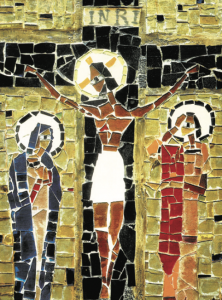
In 1962 Petravičius became director of the Lithuanian Art Gallery, Čiurlionis, in Chicago. In that same year he established and taught at his own studio. In 1964 he taught art classes at the “69” Art Gallery in Chicago. From 1967 to 1971 he was director for the arts at the Chicago Park District – Gage Park, Marquette Park and West Lawn Park. As time went on he realized he was not satisfied as a city dweller. He always had a love of nature.
In 1979 he and his wife, Aldona, moved to Union Pier, Michigan where he felt the freedom of nature. Here he painted the trees, created murals on his house and tended his vegetable garden. In 1982 Kathleen Zmuda of the South Bend Tribune published a multipage article in the Sunday magazine supplement “Michiana” describing Petravičius as an artist of many talents. Included are many of his paintings, sculptures and the murals on his house with a portrait of him on the cover.
In Union Pier, Petravičius was in his element. This however did not last long. His wife Aldona, who long suffered from emphysema, succumbed to the disease in 1985. Aldona had been his muse and inspiration, his everlasting love. Before she died, she selected their final resting place under a large oak tree in Pine Grove Cemetery in Union Pier. Petravičius died four years later in 1989 and is buried next to his wife under a black granite tombstone with an illustration by him titled “Mother of Seven Sorrows.”
Petravičius loved Lithuania till the end of his life. He said “the chains of torture from the Soviet Union would break – and his children and grandchildren would live in a free Lithuania.” That has come to pass and Petravičius will always be remembered, as Ingrida Korsakaitė once wrote, as a “Master Singer of Lithuania through his work.”
Evaluations of his work
In 1991, two years after Petravičius’ death, Algimantas Kezys, a Lithuanian photographer and editor, printed the first in a series of three proposed volumes titled The Art of Viktoras Petravičius. The book was published by Galerija and the Lithuanian Library Press in English and Lithuanian. Kezys presents the chronological events of Viktors’ life accompanied by extensive black and white illustrations of his works photographed at museums in the United States, Lithuania, and Canada and in private homes. Kezys wrote: “Viktoras Petravičius was an artist deeply rooted in his own heritage who spawned countless images under the spell of a rustic mystique found in the small towns and villages of his homeland. The fairy tales of the ancients, their shrines and customs were his main source of inspiration.”
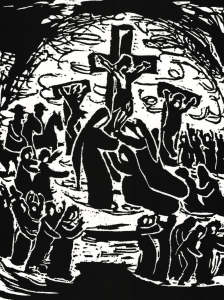
Kezys further notes: “Petravičius says ‘yes’ to the possibility of a transcendental being, where earthly life is transformed into another form or existence. He reinforces the ancient truth that the human spirit lives forever.”
In a book titled Viktoras Petravičius published in Vilnius, Lithuania in 2001, Ingrida Korsakaitė writes as follows: “Petravičius was the first Lithuanian printmaker to deal fundamentally with the ancient mystical layer of national culture and to create the poetic world of the unity of man and nature, intuitively included by mythological memory. In prints the mysterious ritualistic atmosphere and nearly pantheistic spirituality of fauna and flora are reminders of the primordial world outlook. The artist manages to preserve an inborn attraction to nature and its creatures.”
Alexis Rannit, an Estonian art critic, wrote as follows: “Wanting to understand the folk songs and to feel Petravičius’ art one needs to find the Lithuanian soul. For the Lithuanian, the soul is more important than the material reality. Petravičius has an inborn expression of strength.”
Viktoras A. Petravičius was a great Lithuanian graphic artist and always will be remembered for his unique and independent style. His art was always true to his Lithuanian heredity and culture. He loved his native country and created art for Lithuania and Lithuanians. Wherever he lived, he thought of his native land. When love is so deeply rooted in one’s heart, its home is there forever.
____________________________________________________
Five lessons from my grandfather
By Lisana von Braun O’Day
Growing up we all take some things for granted. Only upon reaching adulthood do we take the time to pause and reflect on what we learned from our childhood experiences. These are some reflections of what I learned from my grandfather, Viktoras Petravičius, who was born 1906 in Lithuania and who died in 1989 in Union Pier, Michigan. I was 12 at the time.
Five lessons from my Bočius (Grandpa):

1. Be you.
He would say, Aš esu aš, tu esi tu which translates to “I am I, you are you.” Simple. Or so it sounds – but yet so many of us find ourselves wishing, wanting to be like someone else. Viktoras didn’t wish to be anyone else. He embraced who he was, his own unique style. “Don’t imitate. Be yourself,” are words he lived by. With this outlook, he created boldly, making art that was unlike that of his contemporaries. He stood apart. He stood confidently. He stood true to himself.
2. Be bold and own your strokes. You don’t need much to create.
We all make decisions – we draw our own lines in life. Sometimes I find that I hesitate, unsure, and draw a line that’s shaky. I look at the line, erase it, draw over, carefully and slowly. Viktoras did none of that. He owned his lines; he drew them boldly, rather quickly, and almost with a sense of urgency… as if the line might escape him if he didn’t capture it right at that moment. I remember asking him, “What if you drew a line you didn’t like?” He’d say, “Turn it into one you do like, child.” The lines he drew, he drew with intention, in a strong, bold way. Watching him work on a piece of art was as if he was seeing the image in his head and was drawing exactly what he saw. It was clear in his mind. As an observer, you couldn’t help but think he was cast under a spell…it was as if nothing around him existed anymore; he was in his own space, creating what was so clear to him. You almost felt like an intruder to watch, yet it was hard to not be drawn in and see the beauty that would come from nothing. A blank piece of wood transformed to a beautiful masterpiece. With that masterpiece he would tell the story that he wanted to share with you.
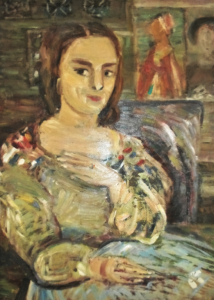
During the latter part of World War II, Petravičius fled Lithuania as a refugee with his wife Marija Aldona Šniukštaitė and their two daughters, Izida and Armide. There wasn’t much material readily available to an artist in a refugee camp. He drew and created on anything he could find, such as linoleum remnants and scraps of wood. In Union Pier, Michigan, where he resided until he died in 1989, he continued to use whatever materials were available to him. He painted huge murals on the exterior of his entire house. He painted on the bark of the evergreen trees outside his home. Strangers would drive by his home and stop to take pictures as it was nothing like you’d ever seen. He made sculptures using cement, empty bottles, bricks, wire, old clay pipes; materials you’d readily discard. His keen eye saw possibilities where others saw only discards. He created beauty from within his soul to share with those around him.
3. Find your muse.
In the 1980s, Petravičius was interviewed for a special documentary by the South Bend, Indiana PBS-TV station WNIT channel 34. It was first broadcast in the Michigan City area in 1982. During the interview he was asked what inspires him. His answers were: Nature, Love, and my wife Marija Aldona. It’s no surprise these were often the subjects of his art – you will see nature and scenes of Lithuania, nature, farm animals, especially in his early art. Love, often depicted in an erotic way with nude figures, were also common subjects. The human body was beautiful and to be celebrated. He found inspiration and was true to it.
4. Life will come with suffering and pain. Love will help you heal.
Petravičius had four children. Two lived to reach adulthood. His second daughter died in Germany at the age of four from blood poisoning. After her death, his art is full of images of suffering and the pain of war and loss. After Petras, his youngest son, he died in a tragic train accident in Chicago at the age of 16, Petravičius’ work became very dark. He continued to be true to himself, painting in these dark moments – sharing his emotion with the world through his art. Throughout all this, he continued to show love for his family: his wife Marija Aldona, his daughter Izida (my mother) and his surviving son Linas. His passion and love for art led him to create some of his most colorful masterpieces in his later years. After his wife died in 1985, Viktoras didn’t paint or create any art for several years. His central muse was gone. He would visit her in the cemetery every day and bring a flower to put on the tombstone he designed for her – a religious image of our Lady of Seven Sorrows. He would tape the flower to her heart and stay there for hours, keeping Aldona company under the large oak tree.
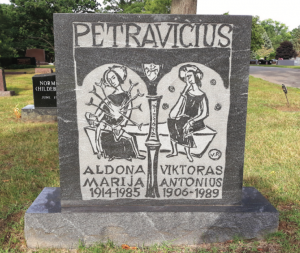
5. Take gratitude in what you have. You don’t need much to be happy.
Viktoras was never rich in terms of money; he considered himself rich with what he had and the talent he possessed. He found joy and took gratitude in so many things that one might often overlook… He loved fresh raspberries; he had a large garden in Union Pier where he grew them. He loved the earth, as he would spend hours hand weeding the garden that he carefully tended. He loved nature and taking early morning walks with his dog, Meška (Bear). He loved howling with Meška at the train’s whistle as it rushed by on the tracks next to his land in Union Pier.
He loved a good joke: tying fresh grapes to the vines outside the window in winter, convincing you that a miracle happened and the grapes were growing amid the snow. He loved a good glass of cognac, a nice piece of steak, an occasional burger from Redamak’s restaurant, and a cup of instant coffee that had at least three teaspoons of sugar. He loved to entertain, to tell stories, to have guests sign his large work table in permanent marker. That table took up half the front room in his house. He loved wearing his white suit – no matter the occasion, no matter the time of year. He loved his family, his grandchildren, and his native country Lithuania. He loved being true to himself. He loved to create. He loved art.
Thank you, Viktoras Petravičius, for all the lessons you have taught me. Thank you for the gifts you have bestowed on us through your talent. May you be forever loved, cherished and recognized as one of the most renowned Lithuanian graphic artists that has lived.
 DRAUGAS NEWS Lithuanian World Wide News in English
DRAUGAS NEWS Lithuanian World Wide News in English
